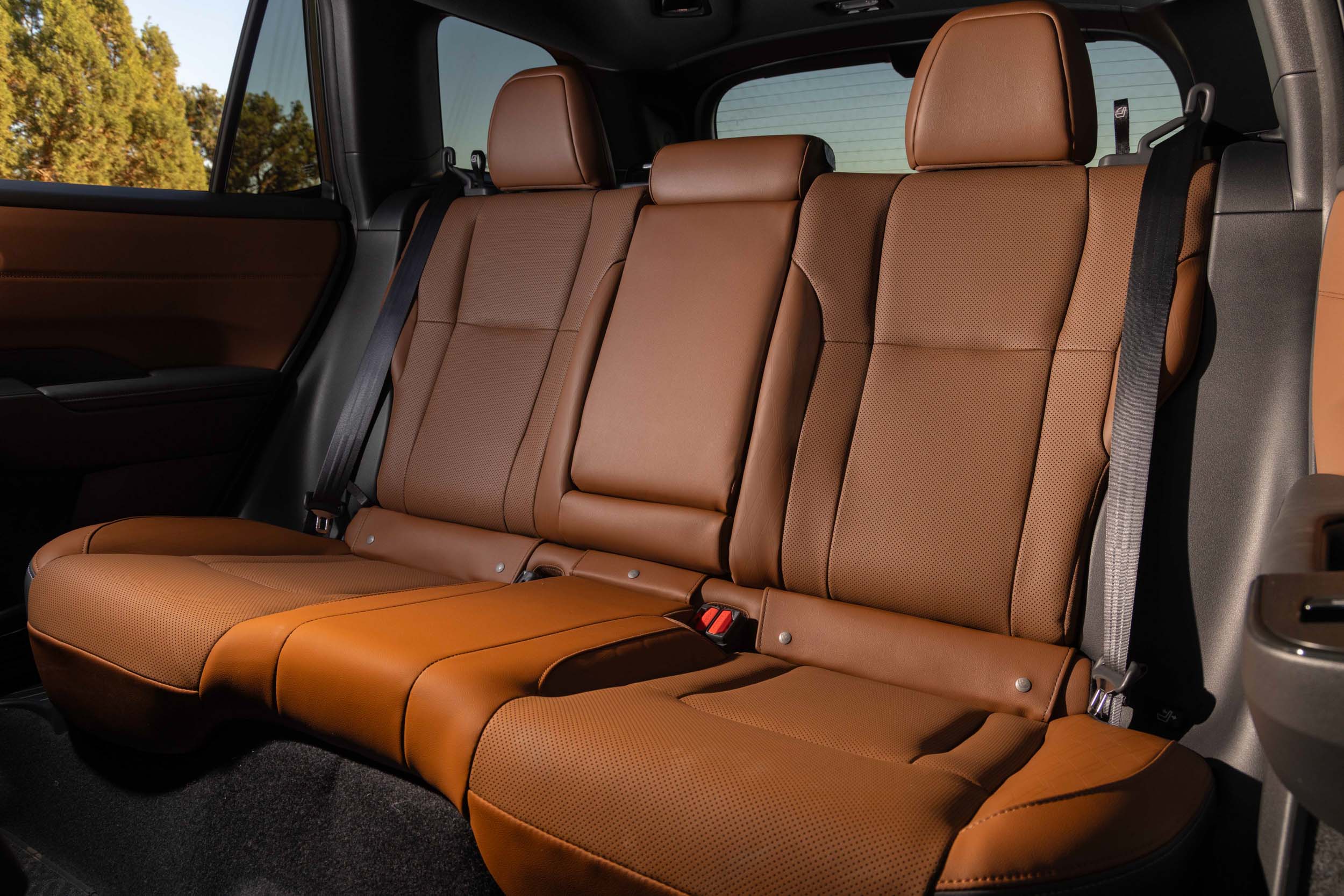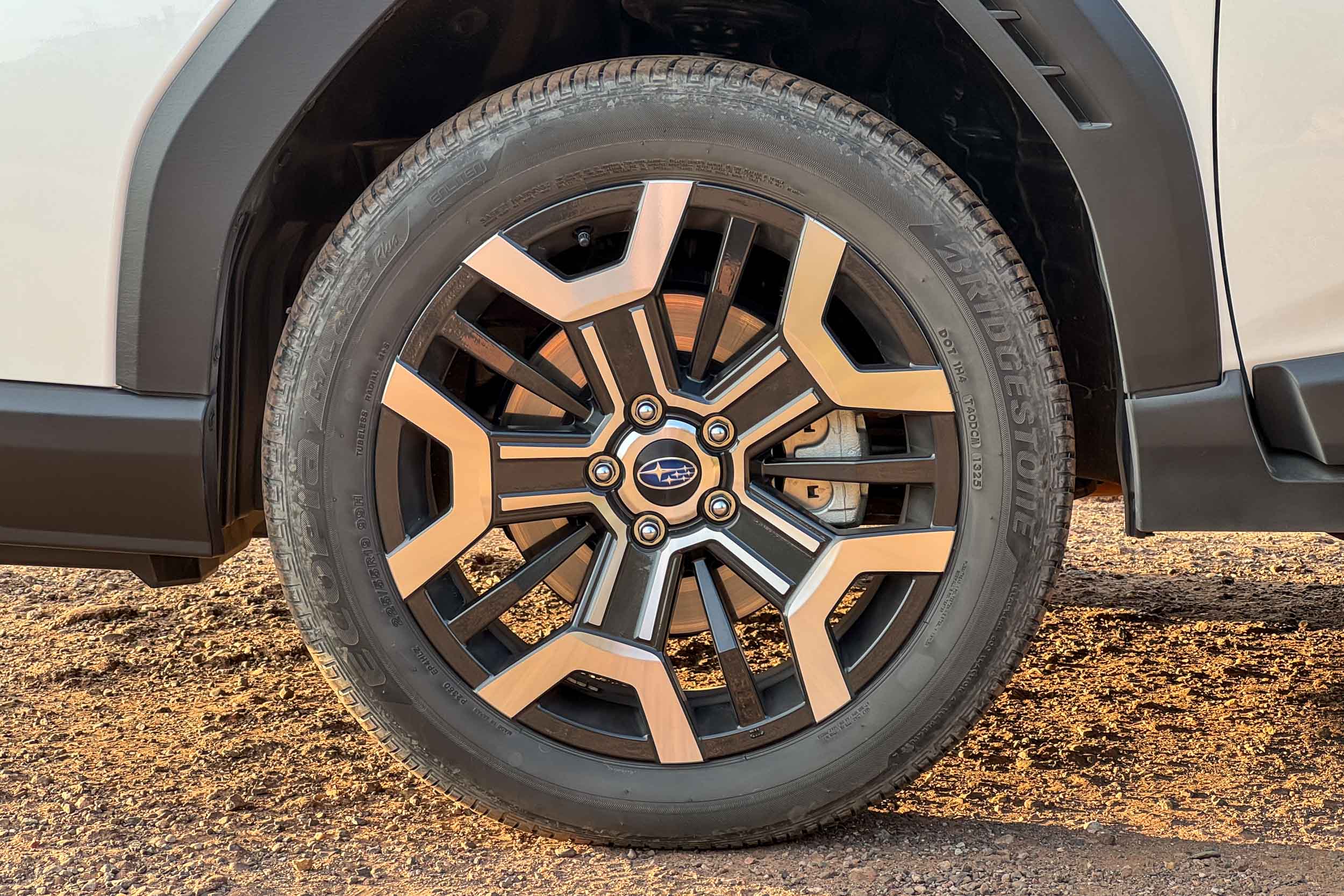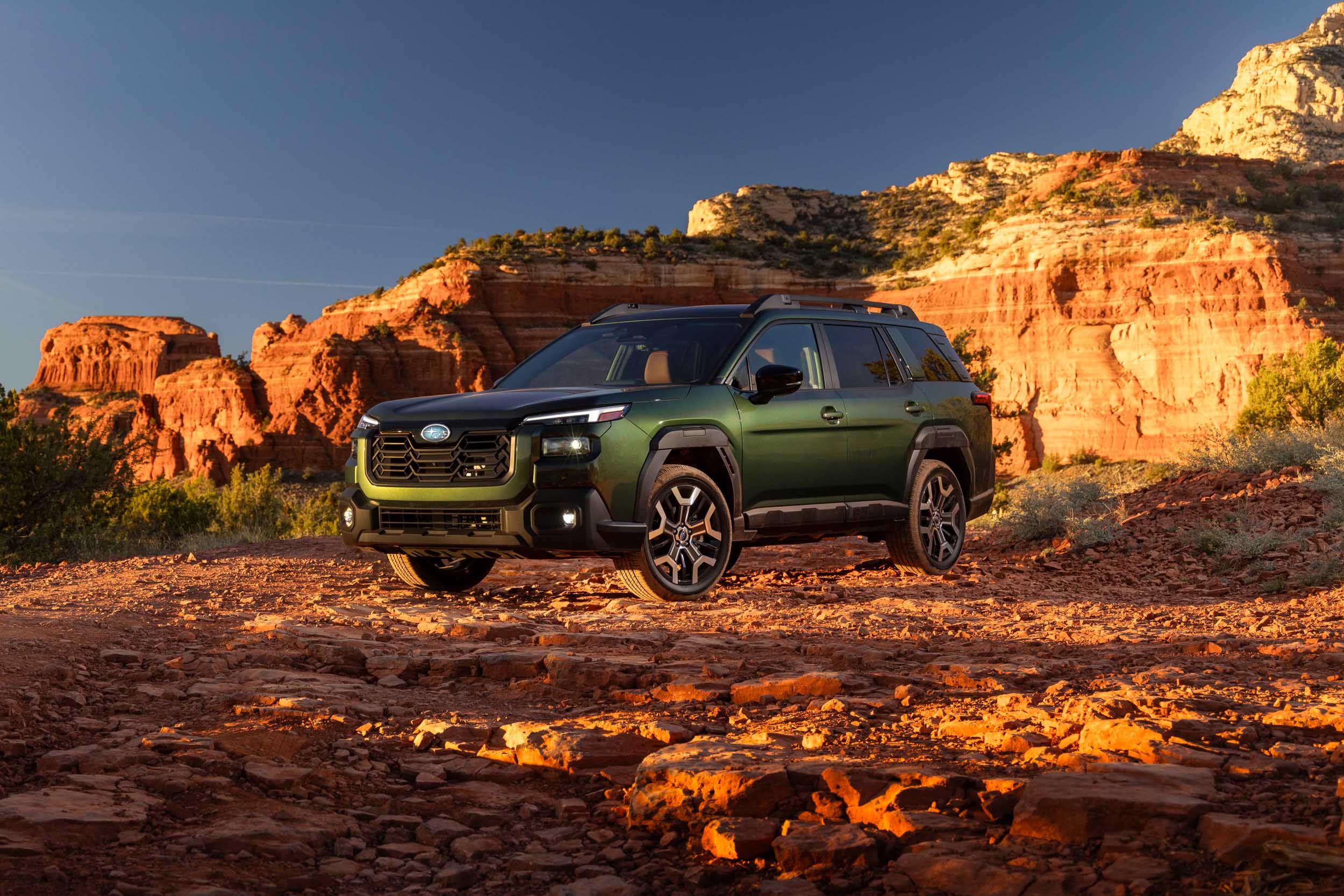I glance at the route guide, “rocky surface ahead.” Having already ascended past 6,000 feet above sea level on a narrow, pockmark-laden, uneven dirt path, I wondered how much more this non-Wilderness Subaru could take.
Turns out, plenty. Courtesy of 8.7 inches of ground clearance and inherent off-road strength in the suspension, the seventh-generation Outback marched right up the trail, even as 6-foot-wide sheets of flat rock and other jagged edges sprang from the ground to attack the tires and underfloor.
It’s moments like this that affirmed my decision to quickly say yes to Subaru’s offer to hitch a ride to Sedona, Ariz., and give this taller, boxier Outback a go. Its new look proved to merely scratch the surface of the work engineers put into its now 30-year-old crossover. But, does it meet the demands of picky, modern-world buyers? Time to find out.
In short: Carrying on with largely similar dimensions to the outgoing model, the new Outback starts at a higher price and looks — frankly — awkward. But the improved refinement in the powertrain, suspension, and cabin isolation more than make up for it. Beyond that, Subaru crammed it full of useful features for those eager to get out in the wild. I particularly like the multipurpose tonneau cover that’s machine washable. The 2026 Subaru Outback remains just as off-road capable and behaves much better while on it.
- Much quieter than before — cabin well-isolated from both road and wind noise
- Ample space and comfort for adults in the second row
- Beefy, 800-pound static load roof rack comes standard
- Clever, multipurpose cargo cover comes standard
- CVT needs a big boot of throttle in some seemingly unnecessary off-road situations
- New styling is an acquired taste
- Split headlight design looks awkward
- Fuel economy figures a bit underwhelming for its class
2026 Subaru Outback Review
New, Taller Shape
Thirty-one years ago, the Outback entered the market as the Legacy Outback, a lifted version of the station wagon with a bit of cladding. Now, the Outback has shucked its wagon shape in exchange for a boxier form.
The seventh-generation 2026 Outback stands 1.4 inches taller than the outgoing model but otherwise stays within 0.2 inches dimensionally. In fact, both ground clearance and wheelbase remain the exact same, 8.7 inches and 108.1 inches, respectively.
Subaru calls it “wagon dimensions with SUV styling.” I call it busy. While the Outback looks functional and purposeful, several contrasting lines weave throughout the body, especially the front end, in a way I find unsettling.

The split headlights exacerbate that sense. DRLs hang out high, main beams mounted in the middle, fog lights down low. Three levels of light.

The new rear end follows the trend, getting full-width taillights across the middle of the tailgate. Beneath that: OUTBACK in large black font. For good measure, the matte black bumper reads SUBARU in massive lettering down low. You also get a roof-mounted spoiler and a much closer to vertical rear windshield. The latter looks appropriate and helps give the Outback more cargo space (more on that in a moment).
Built from the Subaru global platform, the new Outback also benefits from additional work to the aerodynamics and cabin isolation. Engineers incorporated vents at the rear of the front wheel well to relieve high-pressure zones, improved underfloor covers, and even worked to better channel air around the roof rack.

For a bit of splash, Subaru used a “shark skin” texture on the front bumper and “golf ball” on the D-pillar to manipulate the air further. Moreover, the latest Outback received more sound-deadening material. Altogether, it travels down the road much quieter than before. A huge improvement.
Oh, one more thing: The Outback lineup now starts at the Premium trim, and then moves to the Limited, Touring, Limited XT, Touring XT, and finally, the Wilderness, which will arrive in early 2026.
Modernized Inside

For the interior, standard equipment includes a 12.3-inch digital instrument cluster and a 12.1-inch center display. The latter wirelessly connects to both Apple CarPlay and Android Auto. Several practical, user-friendly improvements also came along for the ride. To start, the standard dual-zone climate control system uses dedicated, hard button controls, separate from the center display.

From there, Subaru enlarged the cubby for stuff in front of the shifter and moved the cupholders forward. That makes cups much easier to reach, and spaces for handles allow those cups to be mugs, too. Subaru even added a nice little cable clip to keep charging cords organized, improved seat comfort, and utilized the Outback’s additional height to increase headroom.

As you move up the trim line, Subaru throws in more goodies. While heated front seats come standard, you need at least a Limited trim to also heat the steering wheel and rear seats. Subaru upholsters those seats in leather, by the way, which goes lovely with the power moonroof and wireless smartphone charger.

Touring trims swap in Nappa leather for the interior and also add ventilation to the front seats. Furthermore, you get a full 360-degree view of immediate surroundings, courtesy of the included surround-view camera system.
Cargo Area, Roof Rack, and Multipurpose Cover

In many ways, the real practical genius went into the cargo area. First, the aforementioned more upright rear windshield, combined with the added height, helped increase space by 2 cubic feet with the rear seats up, now 34.6 cubic feet instead of 32.6. Moreover, the cargo opening is taller and closer to square, making it easier to load large things. It’s also a standard power liftgate.

A couple of levers in back, mounted at about shoulder height on either side, make folding the spring-loaded, split second-row seats easy and immediate. Doing so increases cargo space to 80.5 cubic feet.

And use that space in many ways, courtesy of a new, machine-washable, multi-functional cargo cover. Using both hooks and magnetic ends, it mounts itself in several locations in the cargo area. Strap it in the middle of the bay to partition the space. Mount it in back and lay it over the rear bumper to protect the Outback from dirty feet (or paws) or vice versa. Use it as a traditional privacy panel.

Or, my favorite, mount the ends in the middle attachments and give yourself an equipment hammock to keep clean things separate from dirty things. I love it. For even more space, feel free to utilize the ladder-type roof rails, capable of holding up 800 pounds of stuff while stopped and 220 pounds while on the move. It’s the same setup originally only offered on the Outback Wilderness.
To make loading it easier, Subaru included measurements on the rails itself to easily keep the load even from side to side. Finally, Subaru added a removable panel to more readily access a tow hitch.
Oh, and while you use your cargo bay, the new Outback gets a bigger battery, which allows you to power accessories without concern of draining it. Nice. Inflate your paddleboards without worry.
Base Powertrain

Among the six trims offered for 2026, the base Premium, Limited, and Touring trims get propelled by a naturally aspirated, 2.5L flat-four engine. It makes 180 horsepower and 178 pound-feet of torque, matching the new-for-2025 Subaru Forester. That’s 2 fewer horsepower, but 2 more pound-feet than the outgoing 2.5L. The engine attaches to a continuously variable transmission, or CVT, before sending power to all four wheels.
Fortunately, also like the Forester, the new engine runs more quietly and smoothly. It’s far from spritely, however. I got to spend an hour behind the wheel of a Touring equipped as such, meaning its 3,812-pound curb weight resulted in a 21.1:1 weight-to-power ratio.
In my 2026 Outback Touring tester, I buried the throttle from rest, and it eased off the line with little interest in rushing. A couple of seconds later, the engine revs reached its 5,800-rpm power peak and motivated the Outback forward at a respectable clip. I went across back roads, highways, and dirt. In most circumstances, the standard engine moved the Outback along fine. Just don’t ever race for pink slips.
Turbo Power

Thankfully, the Limited XT, Touring XT, and Wilderness swap in a turbocharged 2.4L flat-four — indeed, the same one offered before. And it outputs the same at 260 horsepower and 277 pound-feet of torque. With the 82 extra horsepower, the weight-to-power ratio drops to a much healthier 15.3:1. Like the 2.5L, it bolts up to a CVT before sending power to all four wheels. That combination certainly makes the Outback XT models quicker.
My time with this engine was in a Limited XT. Much of it, I spent off-road. But in those brief moments of pavement, it still resisted hard launches off the line. But once the revs climb toward the now-5,600-rpm power peak. The XT really hustles.
And, while moving, the CVT reacts fast to bring the engine to high revs and provide ample passing power. If you need to pass on a two-lane road, the “kick down” to a lower ratio happens fast, faster than many traditional automatics.
But all of the above comes at a cost at the pump. Without any kind of hybrid help, the Outback falls behind some of its competition. The 2.5L-equipped models manage 25 mpg in the city, 31 on the highway, and 27 combined. Going with the turbo motor drops those figures considerably, managing just 21/29/24 mpg city/highway/combined. That’s well behind the 2026 Honda CR-V TrailSport’s 38/33/35 mpg, for example.

Time for a Cruise
Putting the dragstrip aside, the Outback delivers a comfortable space for four adults, on most any occasion, even a long road trip. At interstate speeds, very little wind or road noise comes through, veering much closer to a premium crossover in quietness.
Moreover, the engine — either engine — stays quiet at nice low rpms while cruising. Traditionally, Subarus have always felt loud and “tinny” to me. No longer — the Outback is a remarkably calming space inside.
Road trips almost certainly will include long stints on the highway, and Subaru’s Eyesight suite of driving aids got a round of updates. Most notably for Touring and Touring XT models, Eyesight now offers a hands-free driving assist — much like GM’s Super Cruise — on select highways and interstates. Except, not quite, the final production software is not yet finished.
For early buyers, a no-cost software update will come soon to add the feature. My Outback Touring included a prototype version of this system, and it worked well during the brief moments I drove on highways the system deemed suitable.

Regardless, you want your hands on the wheel when the going gets twisty. And here, the Outback proved surprisingly enjoyable. Chuck it into a corner, and you will feel understeer as the all-season tires scream in agony.
But the suspension limits body roll, and the all-wheel-drive system lets you apply power aggressively while maintaining chassis balance. It’s like a tall, slow WRX. Fittingly enough, Outback uses a new, more direct-feeling dual-pinion power steering system that’s similar to the WRX.
Where’s the Trailhead?

Fortunately, none of Subaru’s work to improve on-road behavior limited its capability off of it. You still get 8.7-inches of ground clearance. That pairs well with respectable approach, breakover, and departure angle clearances of 18, 21.4, and 19.4 degrees.
My test drive included a long, winding stint up a narrow, pockmarked, uneven, rock-laden trail to a peak 7,800 feet above sea level. The 4,000-foot vertical climb from Sedona kept the Outback on its toes, but the all-wheel-drive system distributed torque to maintain grip, even during the moment when one or even two wheels were dangling in the air.

The only demerit came from the CVT. At a few different moments, large, flat rocks stretched across the trail surface and functioned like a brief, steep ramp to climb. Here, the CVT didn’t want to Outback to budge until I gave it more than half throttle. Then I had to quickly get out of it to keep the Subie from getting squirrely and flinging rocks and loose dirt all over its wheel wells. A traditional automatic with a fixed ratio would help here.
2026 Subaru Outback Review: Pricing & Availability

The base Premium trim starts at $36,445, when you include the $1,450 destination charge. From there, it’s a steady climb to the Limited, Touring, Limited XT, Touring XT, and finally the Wilderness.
My two test cars, a Limited XT and a Touring, cost $46,210 and $47,240, respectively. Adding XT to the title adds about $2,600 to the cost. Aside from acceleration, both trims felt similar: quiet, secure, and capable on the road and off of it. The Outback felt capable for multiple generations now, but never felt this comfortable. The first 2026 Outbacks are rolling into dealerships now.

Read the full article here





